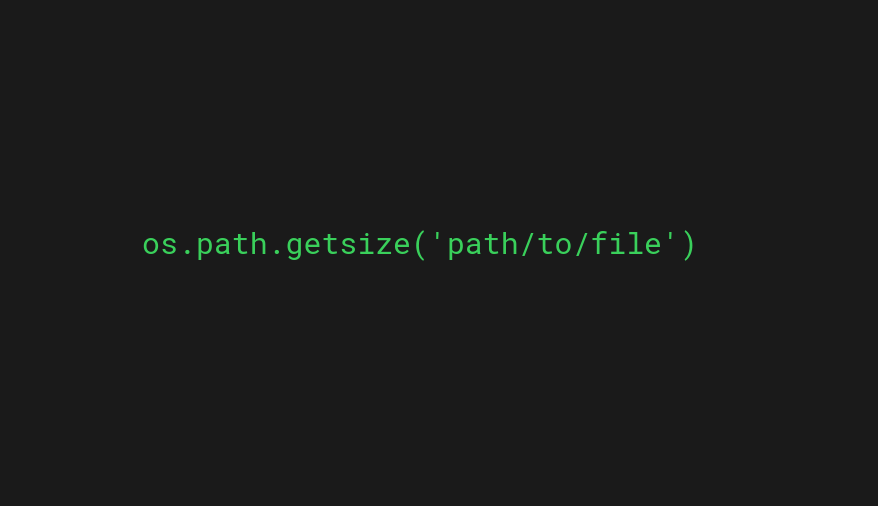
To check the size of a file in Python, use the os.path.getsize() method. This method takes the path of the file as an argument and returns the size of the file in bytes.
import os
file_path = '/path/to/file.txt'
file_size = os.path.getsize(file_path)
print(f'The size of the file is {file_size} bytes.')
The os module is part of the standard library. Thus, you do not need to install it. It is available out of the box in all Python installations.
This is a complete guide to checking the file size in Python.
If you’re looking for a quick answer, the above will surely do! But if you’re looking to find alternative ways to better match your project-specific needs or if you’re just exploring, keep on reading.
This guide teaches you four different ways to get the file size in Python. Besides, you will learn how the different approaches work.
Let’s jump into it!
4 Ways to Find the File Size in Python
The four most common approaches to finding the size of a files using Python are:
- Use the
os.path.getsize()method from theosmodule, which is part of the standard library. This method takes the path of the file as an argument and returns the size of the file in bytes. - Use the
os.stat()method from theosmodule, which returns astat_resultobject that contains information about the file, including its size in bytes. You can access the file size using thest_sizeattribute of thestat_resultobject. - Use the
file.tell()method on an openfileobject, which returns the current position of the file pointer within the file. You can use thefile.seek()method to move the file pointer to the end of the file and then callfile.tell()to get the size of the file. - Use the
pathlib.Path.stat()method from thepathlibmodule, which is part of the standard library. This method takes the path of the file as an argument and returns astat_resultobject that contains information about the file, including its size in bytes. You can access the file size using thest_sizeattribute of thestat_resultobject.
Let’s take a closer look at each of these approaches with examples.
1. The ‘os.path’ Module


The os.path module is a module in the Python standard library that provides functions for working with files and directories. The os.path module is typically used to check the properties of a file or directory, such as its size, permissions, and whether it exists.
Some of the common methods in the os.path module include:
os.path.exists(): checks if a path existsos.path.isdir(): checks if a path is a directoryos.path.isfile(): checks if a path is a regular fileos.path.join(): joins two or more path componentsos.path.getsize(): returns the size of a file in bytes
In this guide, the os module is useful because it allows for checking the size of a file.
How to Check File Size with ‘os.path’?
Here is a code skeleton that shows how you can use the os.path module to check the file size:
import os
file_path = '/path/to/file.txt'
file_size = os.path.getsize(file_path)
print(f'The size of the file is {file_size} bytes.')
Just replace the ‘path/to/file‘ with whatever the path is with respect to the Python file you’re running the script from.
For example, if the file is in the same folder as the Python file, the path to the file is the name of the file. Otherwise, you need to use the directory names and backslashes to construct the path to the target file.
Example
As a concrete example, here I’ve got two files:





The sizefinder.py file is a Python file in which I check the size of the sample.txt file.
Because the files exist in the same folder, the path of the file is just the name of the file.
Here’s what the code looks like:
import os
file_path = 'sample.txt'
file_size = os.path.getsize(file_path)
print(f'The size of the file is {file_size} bytes.')
By running the above code you get a result like this:
The size of the file is 150 bytes.
2. The ‘os.stat’ Function


To check the size of a file in Python, you can also use the os.stat() method from the os module introduced earlier.
This method takes the path of the file as an argument and returns a stat_result object that contains information about the file, including its size in bytes.
Here’s what a generic solution might look like:
import os
file_path = '/path/to/file.txt'
file_info = os.stat(file_path)
file_size = file_info.st_size
print(f'The size of the file is {file_size} bytes.')
Where you need to replace the ‘path/to/file.txt‘ with the actual path to the target file.
Example
Let’s continue with the simple setup in the earlier example. Here are my two files:





The sizefinder.py file is a Python file in which I check the size of the sample.txt file.
Here’s the code you need to place in the sizefinder.py file to find the size of sample.txt:
import os
file_path = 'sample.txt'
file_info = os.stat(file_path)
file_size = file_info.st_size
print(f'The size of the file is {file_size} bytes.')
Output:
The size of the file is 150 bytes.
3. The ‘file’ Object


In Python, a file object provides methods for reading and writing files. The file object is typically used to open a file, read or write data to the file, and close the file once you’re done.
This is what reading a file with the file object might look like:
file = open('/path/to/file.txt')
contents = file.read()
print(contents)
file.close()
In this example, we use the open() function to create a file object for the file at the given path. We then use the file.read() method to read the contents of the file into a string, which we print using the print() function. Finally, we close the file by calling the file.close() method.
The file object provides a number of other methods for reading and writing to files, such as file.write() for writing data to the file and file.seek() for moving the file pointer to a specific position within the file. The latter is useful in many cases, such as when you’re looking to find the size of the file.
How to Check File Size with ‘file’ Object?
To check the size of a file in Python, you can use the file.tell() method, which returns the current position of the file pointer within the file. To call this method, first seek to the end of the file using file.seek(0, 2) and then call file.tell() to get the size.
For example:
file = open('/path/to/file.txt')
# Seek to the end of the file
file.seek(0, 2)
# Get the current position of the file pointer
file_size = file.tell()
print(f'The size of the file is {file_size} bytes.')
file.close()
Here you open the file using the open() function and then seek to the end of the file by passing 0 as the first argument and 2 as the second argument to file.seek(). This sets the file pointer to the end of the file. We then call file.tell() to get the current position of the file pointer, which is the size of the file in bytes.
Remember to close the opened file too!
Example
Let’s continue with the setup seen in earlier examples.





The sizefinder.py file is a Python file in which I check the size of the sample.txt file.
This is what the code looks like:
file = open('sample.txt')
# Seek to the end of the file
file.seek(0, 2)
# Get the current position of the file pointer
file_size = file.tell()
print(f'The size of the file is {file_size} bytes.')
file.close()
Output:
The size of the file is 150 bytes.
4. The ‘pathlib’ Module


The pathlib module is a module in the Python standard library that provides an object-oriented interface for working with files and directories. This module is commonly treated as the replacement for the os module.
The pathlib module provides the Path class, which represents a file or directory path. This class provides a number of methods for working with paths, such as Path.exists() for checking if a path exists, Path.mkdir() for creating a directory, and Path.open() for opening a file.
How to Check File Size with ‘pathlib’?
To check the size of a file in Python, you can use the pathlib.Path.stat() method from the pathlib module.
This method takes the path of the file as an argument and returns a stat_result object that contains details of the file, including its size.
For example:
from pathlib import Path
file_path = Path('/path/to/file.txt')
file_info = file_path.stat()
file_size = file_info.st_size
print(f'The size of the file is {file_size} bytes.')
Notice that the pathlib module is often more convenient to use than the traditional os.path module, which uses strings to represent paths.
Example
Let’s see a concrete example by continuing with the setup seen in earlier examples.





The sizefinder.py file is a Python file in which I check the size of the sample.txt file.
This is what the code looks like:
from pathlib import Path
file_path = Path('sample.txt')
file_info = file_path.stat()
file_size = file_info.st_size
print(f'The size of the file is {file_size} bytes.')
Output:
The size of the file is 150 bytes.
Thanks for reading. Happy coding!